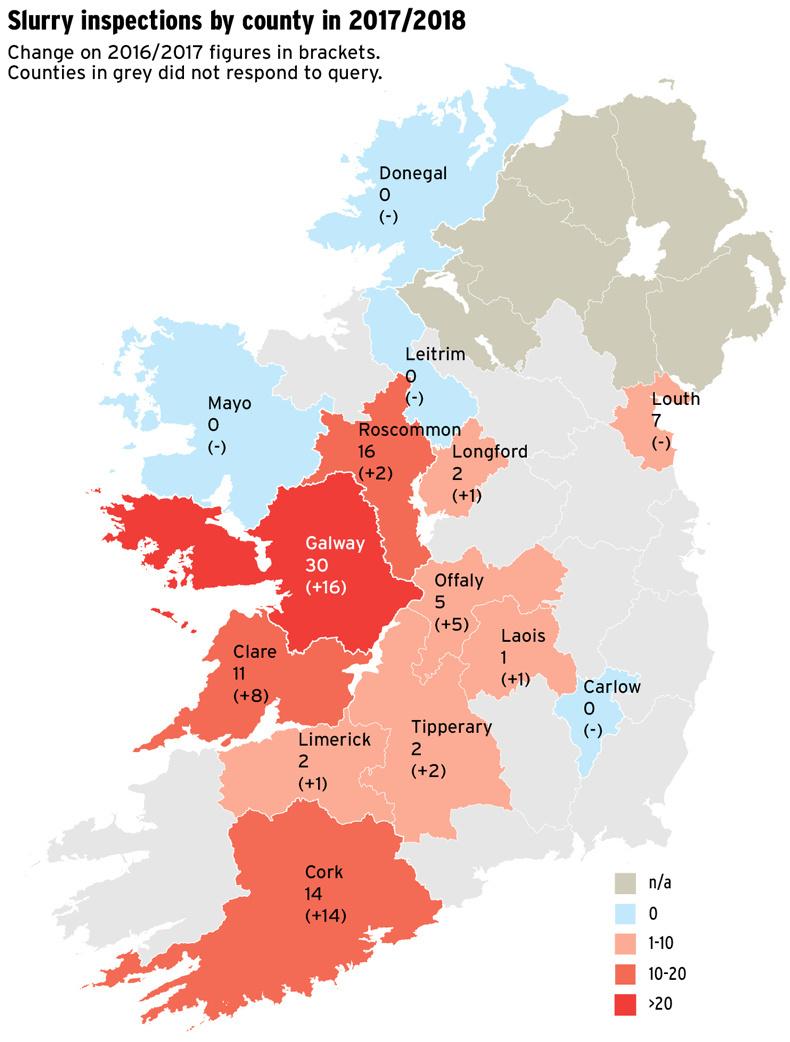County council slurry spreading inspections in the closed period more than doubled in the 2017/2018 period compared with the previous year, the
Irish Farmers Journal has learned.
Ten county councils carried out 90 slurry spreading inspections in the 2017/2018 closed period, up from 40 for the same period last year, as the map shows.
Galway had the highest number of inspections at 30, up from the 14 that took place in the 2016/2017 closed period.
Inspections in Cork went from none in the 2016-2017 closed period to 14 in the 2017-2018 closed period. In Clare, inspections increased from three to 11.

A spokesperson for Mayo County Council told the Irish Farmers Journal that on 4 December 2017, the council received a list of some of the farmers that had applied to spread slurry during the closed period and had availed of the flexibility to do so.
The list showed that of 33 farmers who had applied, 31 spread slurry between 15 October and 4 November. However, it was clear that the slurry had been spread for a month or more, so no inspections took place, given the time period that had passed.
Some of these farms, which were selected on a water quality risk-based assessment, are to be inspected in the first quarter of 2018, the spokesperson said.
Rain
Last year, heavy rainfall across the country saw almost 600 farmers apply to spread slurry after the closed period, a 630% increase on 2016 levels.
Of this number, 283 farmers proceeded to spread slurry after the closing date.
What was assessed in the inspections?
Storage tanks and dung steads available on each farm for the collection of all farm effluent.Tank sizes and assessment of whether or not there was adequate storage available.An examination of the fields used on each farm for land spreading slurry after the open period.Why it was necessary to spread slurry during the closed season.What equipment was used to spread slurry.What measures are planned to avoid this problem in winter 2018/2019.The farm’s capacity for the storage of slurry.Current stocking rates. Read more
Snow leads to increase in slurry problems
Slurry buffer zones increase
County council slurry spreading inspections in the closed period more than doubled in the 2017/2018 period compared with the previous year, the
Irish Farmers Journal has learned.
Ten county councils carried out 90 slurry spreading inspections in the 2017/2018 closed period, up from 40 for the same period last year, as the map shows.
Galway had the highest number of inspections at 30, up from the 14 that took place in the 2016/2017 closed period.
Inspections in Cork went from none in the 2016-2017 closed period to 14 in the 2017-2018 closed period. In Clare, inspections increased from three to 11.

A spokesperson for Mayo County Council told the Irish Farmers Journal that on 4 December 2017, the council received a list of some of the farmers that had applied to spread slurry during the closed period and had availed of the flexibility to do so.
The list showed that of 33 farmers who had applied, 31 spread slurry between 15 October and 4 November. However, it was clear that the slurry had been spread for a month or more, so no inspections took place, given the time period that had passed.
Some of these farms, which were selected on a water quality risk-based assessment, are to be inspected in the first quarter of 2018, the spokesperson said.
Rain
Last year, heavy rainfall across the country saw almost 600 farmers apply to spread slurry after the closed period, a 630% increase on 2016 levels.
Of this number, 283 farmers proceeded to spread slurry after the closing date.
What was assessed in the inspections?
Storage tanks and dung steads available on each farm for the collection of all farm effluent.Tank sizes and assessment of whether or not there was adequate storage available.An examination of the fields used on each farm for land spreading slurry after the open period.Why it was necessary to spread slurry during the closed season.What equipment was used to spread slurry.What measures are planned to avoid this problem in winter 2018/2019.The farm’s capacity for the storage of slurry.Current stocking rates. Read more
Snow leads to increase in slurry problems
Slurry buffer zones increase







 This is a subscriber-only article
This is a subscriber-only article










SHARING OPTIONS: